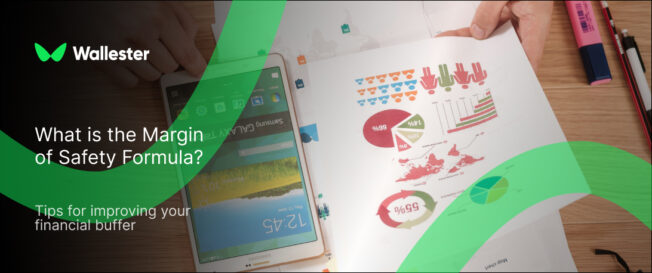When a business is planning for stability, the margin of safety is a useful figure. It shows how much sales can drop before the company hits its break-even point. This calculation helps managers, accountants, and investors understand how much breathing room there is before a business starts losing money. It can guide important decisions like whether to launch a new product, adjust pricing, or restructure spending across company departments. Knowing this number means you’re not relying on guesswork – you’re using data to see how close you are to the financial edge.
Key takeaways
- The margin of safety shows how far actual sales are from the break-even point.
- It can be shown in units, value, or as a percentage.
- A higher margin means more room for error in planning and forecasting.
- Businesses use it to prepare for slow periods or economic downturns.
- It helps with budgeting, pricing, risk review, and sales break-even analysis.
Margin of safety explained
The term refers to the gap between your current sales and the minimum sales needed to cover all your fixed and variable costs. It gives a company a buffer – if revenue drops, how much can it fall before the business is no longer profitable? This number is important when evaluating how much risk a company can tolerate before changes in sales start cutting into profits.
This idea plays a big role in break-even analysis. A break-even point is the level of sales where your total revenue equals your total costs. Above that point, the business makes a profit. Below it, you’re in loss territory. So, the margin of safety tells you how close you are to the line between operating in the green or red. Understanding margin like this allows businesses to build more accurate forecasts and react faster when trends shift.
A wide margin means there’s less risk of falling below break-even. A narrow one signals you may need to review your cost structure or pricing strategy. Many companies monitor their margin regularly, especially when market demand is unpredictable or when they rely on seasonal sales to maintain profit levels.
What is the importance of a margin of safety?
A strong margin of safety helps companies face uncertainty. Sales don’t stay steady throughout the year – there may be off seasons, changing demand, rising costs, or economic disruptions. Knowing your margin can guide decisions and alert you when you’re cutting things too close. It gives businesses time to prepare rather than react, which can mean the difference between temporary struggles and long-term financial damage.
For investors, this concept matters too. When buying stocks, some use the margin of safety idea to compare a company’s market price to its estimated intrinsic value. If the stock price is far below the estimated value, there’s room for it to drop without causing a loss – at least in theory. This approach reduces the chance of overpaying, which can help protect money during market downturns.
In both business and investing, safety serves as a cushion that reduces risk during unexpected turns. It encourages conservative thinking and helps avoid decisions based on overly optimistic assumptions. By relying on the margin of safety, professionals create space for uncertainty while staying grounded in actual data.
Further Reading: Expense Accounts Explained
Margin of safety use cases
The margin of safety can be useful in a variety of situations across different company departments. Each team may use the number in different ways, depending on their goals and responsibilities.
- Sales forecasting. Helps teams understand how much sales can fall before losses start. It can also guide goal setting and performance evaluation.
- Budgeting. Guides spending plans based on projected revenue, minimal fixed costs, and variable costs. It keeps departments aligned with company-wide sales expectations.
- Pricing decisions. Ties into whether pricing adjustments will leave enough of a buffer between break-even sales and actual sales. It’s helpful when reviewing whether new discounts or promotions are worth it.
- Product lines. Helps identify which products bring in the strongest margins and which might need review or replacement. A product that looks profitable may contribute little to the overall margin if its fixed costs are high.
- Investing. Applied in stock valuation when comparing intrinsic value to current market prices. Investors often apply a discount to fair value as part of their safety strategy.
Different company departments may look at the same resources through different lenses. A finance team may focus on the margin of safety in terms of accounting figures and fixed cost levels, while a marketing team might use it when evaluating pricing risks during campaigns. Operations might analyze safety margins to determine whether production volumes need to increase during high seasons.
What is the margin of safety calculation?
The margin of safety calculation is a simple way to measure how much above the break-even sales your actual or budgeted sales are. It can be done in either total currency value (like pounds or euros), as a percentage, or in terms of units sold. Each method gives useful insight into how secure the business is from unexpected changes in performance.
There are three main ways to present it:
- In value: This is the difference between actual sales and break-even sales. It gives a clear view of the amount of revenue protecting the business.
- As a percentage: This expresses the margin relative to actual sales. It’s helpful when comparing across departments, product lines, or different companies.
- Per unit: This shows how many units you’re selling above the break-even volume. This method is ideal when tracking individual products or services.
The method you choose depends on your goals. For quick checks, the percentage version is popular. But if you’re calculating based on a specific product line, per-unit values can be helpful. In budgeting, value-based safety margins help with allocating funds wisely and forecasting risks.
Margin of safety formula
There are several ways to calculate margin of safety, depending on what you’re measuring. Regardless of method, the formula always compares current sales to break-even sales in one way or another. It tells you how much room you have before reaching a point where your income stops covering your costs.
Calculating margin of safety as a percentage
To find the margin of safety percentage, use this formula:
(Actual Sales – break-even Sales) ÷ Actual Sales × 100
This version shows how much of your current sales is above the break-even point. The higher your margin, the more secure the business is if sales slow down. It’s especially helpful when comparing different company departments or product lines.
Safety calculation example:
If your actual sales are £100,000 and break-even sales are £80,000:
(100,000 – 80,000) ÷ 100,000 × 100 = 20%
So, your safety percentage is 20%. That means your business could lose up to one-fifth of its current sales and still not lose money. This type of information supports smarter pricing and cash flow strategies.

Calculating margin of safety per unit sold
If you want to know how many units you’re selling beyond the break-even point, use:
Actual Units Sold – break-even Units Sold
This helps you see how many units can stop selling before the company starts losing money. This formula is often used in production-focused teams that need to evaluate product-level performance.
Example:
If your business sells 5,000 units and your break-even point is 3,500 units:
5,000 – 3,500 = 1,500 units
That means you have a 1,500-unit buffer. It’s a useful figure when analyzing how pricing, costs, or discounts might impact profitability. Even small shifts in fixed or variable costs can make a difference in your buffer, which is why regular updates are important.
Further Reading: The Complete Guide to Managing Expenses for Online Retailers and Resellers
Practical example of margin of safety calculation
Let’s say you run a clothing business. Your budgeted sales for the quarter are £60,000. Your break-even point is £45,000. To find your margin of safety in value:
60,000 – 45,000 = £15,000
Then, for the percentage:
15,000 ÷ 60,000 × 100 = 25%
That means sales can fall by £15,000 (or 25%) before you stop covering your fixed and variable costs. This number offers insight into how long your company can survive during slower periods or market downturns.
You might also calculate your margin in units sold. If the selling price per unit is £30, and fixed costs are £45,000, and variable costs are £10 per unit, then:
break-even units = 45,000 ÷ (30 – 10) = 1,500 units
Actual units = 60,000 ÷ 30 = 2,000 units
Margin of safety in units = 2,000 – 1,500 = 500 units
This helps you visualize the gap using actual operations data.
Analysing your margin of safety
Once you’ve done the safety calculation, it’s time to think about what it tells you. A low margin of safety can signal that your pricing is too low, your fixed costs are too high, or that demand is unstable. It may also reflect problems with your cost structure, such as depending heavily on one product line or failing to adjust expenses during seasonal downturns. If sales dip during slow periods, you might run into trouble fast – especially if your company relies on consistent monthly revenue to cover overhead. This is particularly important for businesses with tight cash flow or those operating in competitive markets where pricing flexibility is limited.
Meanwhile, a high safety margin means your company can absorb drops in demand without big changes. It shows there’s enough of a gap between your actual sales and break-even point to continue daily operations even when the market becomes unpredictable. Generally speaking, this gives you more time to react, adjust, and stay profitable. It’s easier to try out new ideas, launch services, or explore promotions when you have some room to work with. You can also shift resources between departments more confidently, knowing that small mistakes or slower performance in one area won’t instantly put the entire business at risk.
At the same time, margin of safety is just one piece of the puzzle. It doesn’t account for changes in cash flow, delayed payments, or shifts in fixed costs, and it won’t highlight deeper issues like customer churn or inefficient internal processes. So while it helps with short-term planning and pricing checks, it shouldn’t be your only measure of performance. To get a complete picture, combine it with other tools like gross profit margins, return on sales, and cash flow analysis. Looking at several indicators together helps you understand whether the company is truly in a stable position – or just temporarily surviving.
Is there a good margin of safety percentage?
What makes a good margin of safety varies by industry. There’s no universal number that applies to every business, but there are common benchmarks that can guide your analysis. Companies with stable demand and low risk – such as those in utility services or essential goods – might operate with a smaller buffer because their revenue is more predictable. In contrast, businesses in high-risk sectors, such as fashion, hospitality, or tech startups, often deal with volatile demand, higher competition, or irregular income streams. These businesses may aim for a much higher minimum margin to protect against sudden drops in performance.
As a general rule:
- 10–20% is considered acceptable in steady industries where customer demand remains fairly constant.
- 30% or more is ideal in unpredictable markets or early-stage ventures where sales may fluctuate and cost recovery takes longer.
Some companies that offer a range of products or services might set different targets across departments. For example, a business may accept a lower margin on entry-level products while maintaining a higher one on premium offerings. The goal is to balance volume with profitability without exposing the company to unnecessary risk.
However, even a small buffer is better than none. If your business model relies on volume-based sales or operates with low margin goods, maintaining any measurable gap between actual and break-even sales helps reduce the chances of slipping into losses during quiet months. The lower your risk tolerance, the more important the margin becomes. Some businesses operate with less than a 10% buffer, which might be acceptable during strong periods when demand is steady, but it becomes much more risky during economic downturns, unexpected delays, or supply chain disruptions. Ideally, your margin should match your comfort level with uncertainty and your ability to adapt quickly.
Further Reading: What is Pro Rata: An Ultimate Guide
The best ways to improve safety margins
If your margin of safety seems tight, don’t panic. There are practical steps you can take to strengthen it. These steps may require small changes to pricing, better control over expenses, or smarter planning between different teams.
Here are a few proven ways to improve your buffer:
- Reduce fixed costs. Cutting recurring overheads like rent or salaries helps lower the break-even point. Even switching suppliers or renegotiating contracts can have a noticeable effect.
- Increase revenue. Adjust pricing or increase volume sold to raise your actual sales figures. Look for upselling opportunities or new markets.
- Review product pricing. If the selling price per unit is too low, even small gains can create better margins. Consider revisiting your pricing model.
- Refocus on profitable product lines. Drop or revise those with consistently low margin performance. Some services might require more resources than they’re worth.
- Recalculate often. Business conditions change, and keeping an eye on your safety margin helps you adapt. Make it a regular part of your financial reviews.
Companies with low margin operations often face pressure from many sides – suppliers, competitors, customers. Improving the safety margin can offer breathing room in those situations and help avoid tough decisions later.
How Wallester can help
For business owners looking to keep control over sales, costs, and margins, Wallester Business offers tools that support smarter decisions and more accurate reporting. Whether you’re monitoring actual sales against break-even targets or planning budgets for different departments, Wallester’s financial tools can simplify the process.
With real-time tracking of transactions and clear visibility over spending, you can better understand your cost structure and make faster adjustments. You’ll also have detailed analytics that help with forecasting, pricing decisions, and comparing sales across product lines.

Key features include:
- Customisable corporate card settings to manage spending by category or department.
- Multi-user dashboards for finance teams to monitor sales and expenses.
- Data export and reporting tools to help with budgeting, cost control, and sales break-even analysis.
- Multi-currency support for businesses operating across regions.
Wallester helps businesses reduce costs, track progress toward revenue goals, and understand how much sales they need to stay safe. When your team has access to the right tools, it becomes easier to calculate margin of safety accurately and apply it in day-to-day operations.
Are there any negative margins of safety?
How can the calculation of the margin of safety help my business?
How is the MOS ratio calculated?
(Actual Sales – break-even Sales) ÷ Actual Sales
This gives a decimal number that shows the percentage of current sales that exceed the break-even level. It’s commonly used to compare performance over different time periods.
What is the formula for the margin of safety P/V ratio?
(Contribution ÷ Sales) × 100
A higher P/V ratio helps increase your safety margin because it means more profit is generated per unit of sale.



